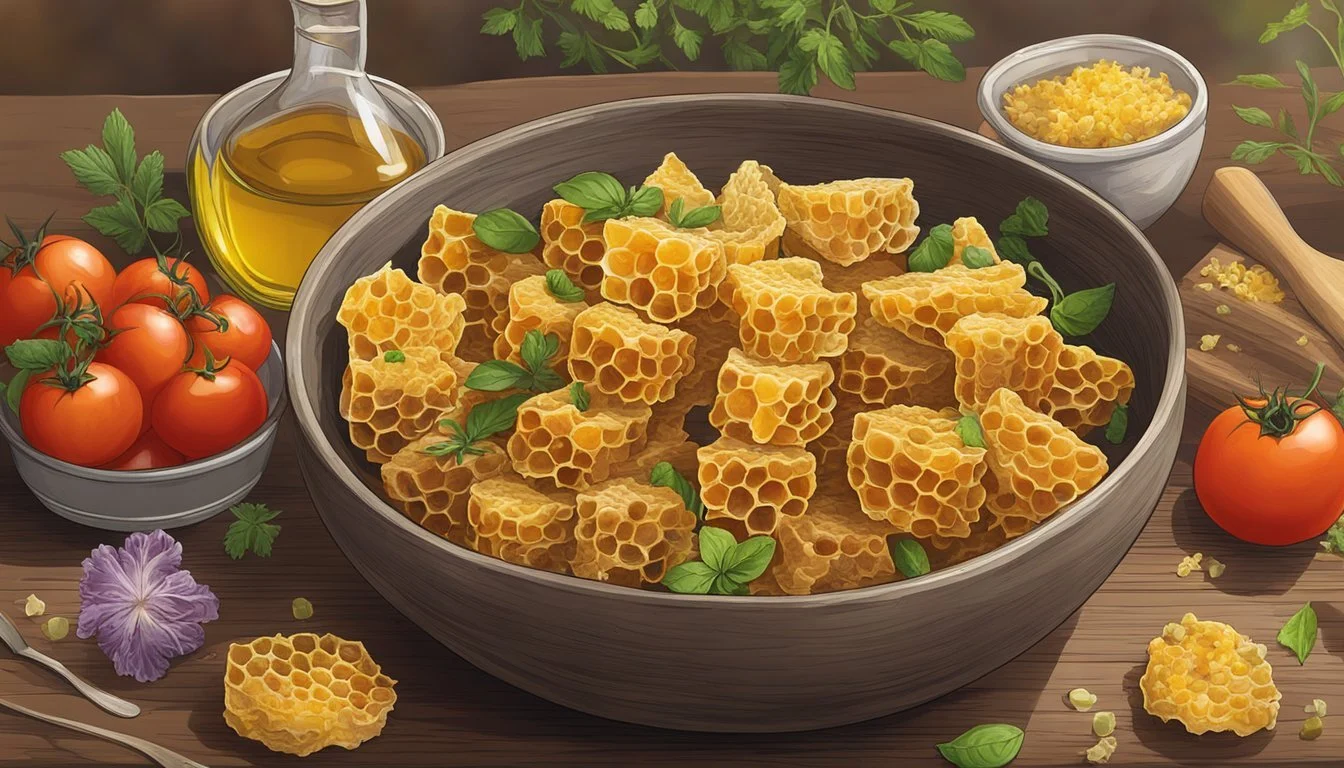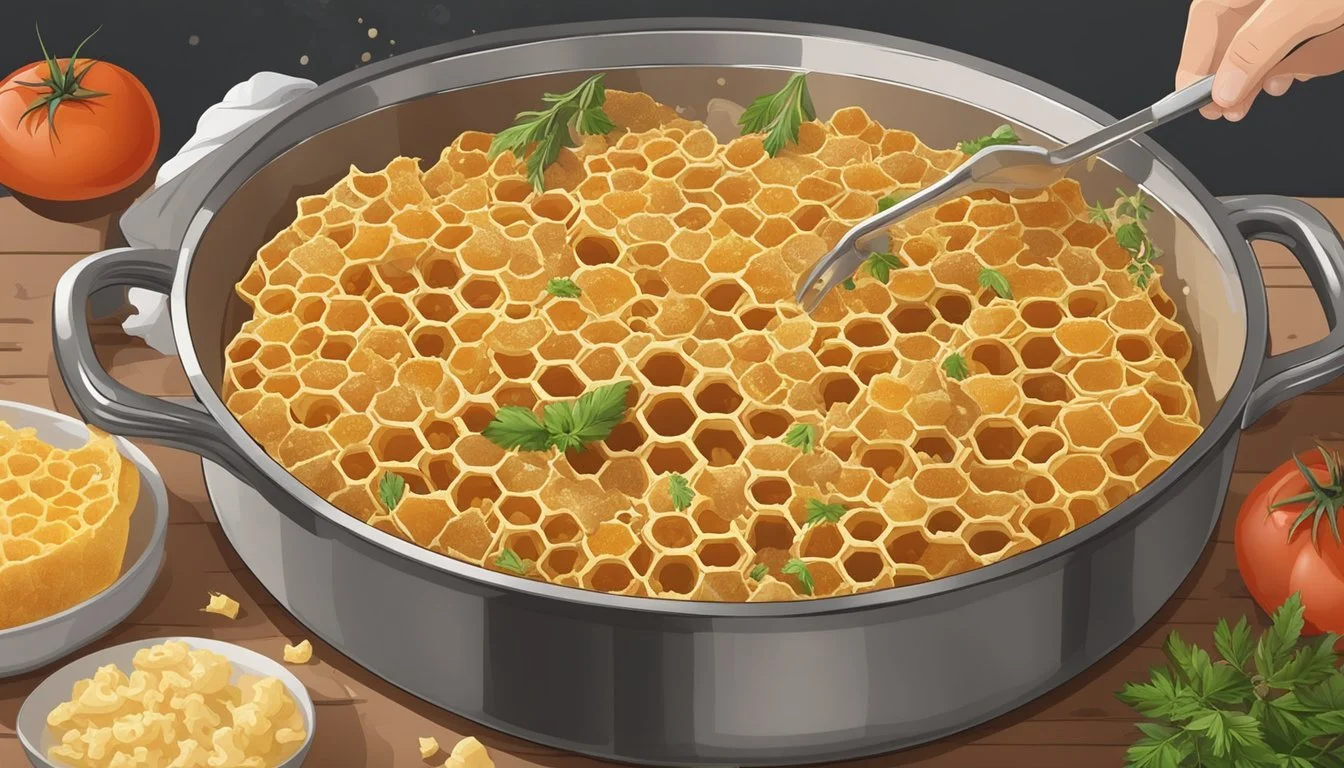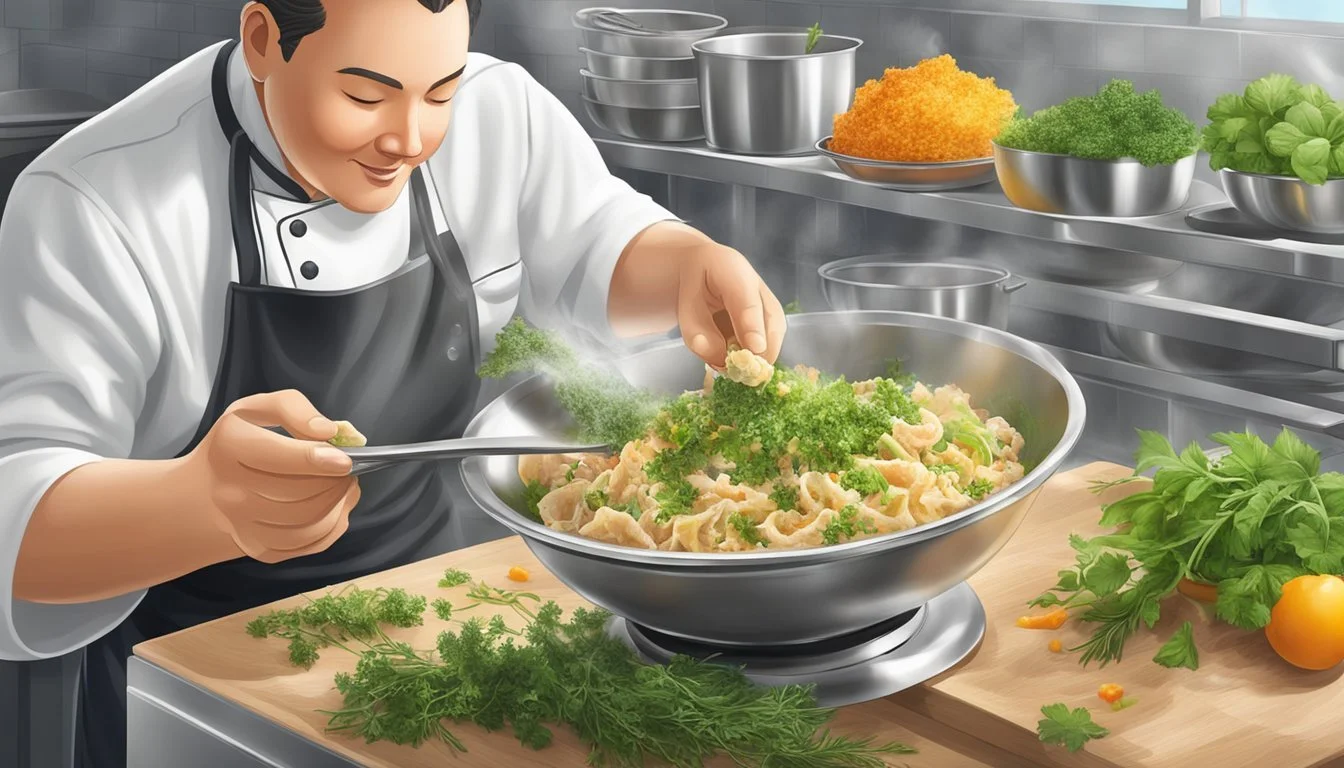Honeycomb Tripe
Exploring the Delights of Italian 'Trippa' Cuisine
Honeycomb tripe, a culinary gem in Italian cuisine, stands as a testament to the ingenuity and tradition that epitomizes Italy's gastronomic heritage. Often referred to by its Italian name 'trippa,' this particular cut of beef stomach offers a distinctive honeycomb pattern that is not only visually intriguing but also contributes to its unique texture. Esteemed for its chewiness and ability to absorb flavors, honeycomb tripe serves as a canvas for the rich and aromatic components of Italian cooking.
Italian dishes celebrating tripe, especially within Rome’s culinary scene, are much more than mere peasant food; they embody a deep connection to history and place. In a classic trippa alla romana, the tripe is slow-cooked with a harmonious blend of tomatoes (What wine goes well with tomatoes?), onions, (What wine goes well with onions?) and carrots, along with a careful seasoning of salt and herbs, transforming the tough offal into a tender, hearty fare. The long cooking process mellows the tripe’s robust shape and texture into a delicacy that is both warming and satisfying.
Integral to a successful tripe dish is the preparation of the tripe itself, which involves thorough cleaning and a simmering process to reach the desired tenderness. Italian butchers and chefs alike understand the value of selecting high-quality tripe, knowing that a piece that is too white might indicate overbleaching, while a proper piece should exhibit a natural hue and thick cords. Once adequately prepared, this offal becomes a vehicle for the rustic and homely flavors that characterize Italian cooking, offering a textural journey through every bite.
The History and Significance of Tripe in Italian Cuisine
Tripe, the edible lining from the stomachs of various farm animals, holds a place of reverence in Italian cuisine, showcasing the ingenuity of utilizing all parts of the animal in cooking.
The Origins of 'Trippa'
'Trippa,' as it is known in Italy, is not merely a dish but a historical testament to an age when no part of an animal was wasted. Its origins can be traced back to the Roman era, a time of practical cooking, where every morsel from a butchered animal was used. Initially considered peasant food, it has evolved over the centuries to be embraced across all strata of society.
Tripe's Place in Italy's Culinary Tradition
Tripe is celebrated in Italian cuisine for its unique texture and versatility. It gained prominence during lean times, especially in post-war periods when more luxurious cuts of meat were scarce. Italian tripe dishes are often cooked with rich tomato sauces, herbed broths, and topped with a generous shower of cheese, such as pecorino romano in Rome or parmigiano-reggiano in regions like Milan. Its presence on the Italian table is a nod to the tradition of "cucina povera" or the art of making simple ingredients Shine.
Regional Variations
From Florence to Rome and Milan, tripe takes on various forms and flavors:
Florence is known for lampredotto: a flavorful, slowly simmered dish often served in sandwiches and considered street food.
In Rome, Roman-style tripe, 'Trippa alla Romana', incorporates a savory tomato sauce and is commonly finished with refreshing mint and pecorino romano cheese.
Milanese cooks have their own take, favoring a lighter approach, typically eschewing the intensity of tomato-based sauces (What wine goes well with tomato-based sauces?) for a more subtle, herby concoction.
Dishes such as these paint a comprehensive picture of tripe’s integral role across the different spectrums of Italian cuisine, representing regional identities and local culinary techniques.
Understanding Honeycomb Tripe
Honeycomb tripe is the edible stomach lining of cows, specifically the second chamber, the reticulum. Recognized for its unique texture, it's a delicacy in Italian cuisine and classified among variety meats or organ meats.
Anatomy of the Stomach: Rumen, Reticulum, Omasum, and Abomasum
A cow's stomach is divided into four chambers: the rumen, reticulum, omasum, and abomasum. Each of these chambers has a distinct function in the digestive process.
The rumen is the largest compartment, responsible for fermenting ingested plant-based food with the help of microbes.
The reticulum, which provides honeycomb tripe, has a honeycomb texture that traps foreign matter, preventing it from entering the animal's digestive system.
The omasum filters out large particles, absorbing water and nutrients from the digesta.
Finally, the abomasum is the true stomach where the digestion process is completed, similar to the stomach function in humans.
Selecting Quality Tripe at the Market
When at the market, one should know how to identify high-quality honeycomb tripe. Fresh tripe should:
Have a pale, off-white color indicating proper cleaning and bleaching.
Emit a mild scent; a strong odor may indicate spoilage.
Be moist but not overly slimy to the touch.
It is essential to select tripe that looks fresh and has been processed and stored adequately to ensure safety and quality.
The Four Chambers and Their Uses
Each of the four chambers of a cow's stomach can yield tripe, but the honeycomb pattern from the reticulum is particularly sought after. The various types of tripe are used in different dishes:
Rumen (blanket tripe) is flat and often used in stews (What wine goes well with stews?).
Reticulum (honeycomb tripe), due to its texture, is preferred for dishes that require slow cooking, allowing it to absorb flavors.
Omasum (book/bible tripe) has thick leaves and is less commonly eaten but used in some Asian cuisines.
The abomasum is typically not used for tripe dishes.
Each type manifests a unique texture and flavor profile, adding depth to a broad spectrum of recipes.
Preparing the Base Ingredients
For an authentic Italian tripe dish, the preparation of fresh vegetables and a robust flavor foundation are essential steps. These create the bedrock upon which the tripe's unique texture and taste will be showcased.
Chopping the Vegetables
The typical vegetable base, known as a "soffritto" in Italian cooking, is comprised of onion, carrots, and celery. It is critical that these vegetables are finely diced to ensure they meld well with the overall dish, delivering flavor without overpowering the tripe's delicate taste.
Onions should be peeled and finely chopped.
Carrots need to be peeled and then diced into equally small pieces.
Celery stalks are thoroughly washed and similarly chopped to size.
The precision in chopping ensures a consistent texture in the soffritto and an even cooking time.
Creating the Flavor Foundation
The foundational flavors begin with heating olive oil in a pan and adding garlic (What wine goes well with garlic?) and chili pepper. Garlic cloves should be crushed to release their aroma and flavor but remain large enough to be removed easily before serving. Chili peppers, either fresh or dried, are added depending on the desired level of heat. The key is to:
Heat the olive oil at medium temperature.
Add the garlic and chili pepper, allowing them to sizzle but not brown.
Incorporate chopped vegetables, stirring occasionally, until they're soft and fragrant.
Fresh herbs like parsley and mint may also be added for more complexity. Parsley should be finely chopped, whereas fresh mint, a less common but bright addition, must be torn to avoid bitterness and to release its full flavor. This aromatic base sets the stage for adding the tripe and further ingredients like tomato sauce, giving the dish its characteristic rich and hearty essence.
The Core of Italian 'Trippa': Key Components and Techniques
Italian 'Trippa' dishes thrive on simplicity and the genuine flavors of their quality ingredients. Mastering the core components of tomatoes, spices, and tripe, and understanding the nuances of the cooking process, allows one to craft a 'Trippa' that stays true to its traditional roots.
Cooking with Tomato: Sauce vs. Paste
To begin the journey of 'Trippa', one must decide between tomato sauce and tomato paste for the base. Traditional recipes often call for canned tomatoes crushed by hand or a smooth tomato sauce, to provide a rich and delicate background. Tomato paste, being concentrated, can be used sparingly to enhance the depth of the sauce. The balance of tomato acidity and sweetness is typically tailored with a hint of vinegar or sugar.
Tomato Sauce: Offers a lighter, fresher taste.
Tomato Paste: Intensifies flavor with a thicker consistency.
The Art of Simmering
Simmering is a pivotal technique in 'Trippa'. A prolonged, gentle simmer allows flavors to meld and the beef tripe to soften to the right texture. Key to this process is maintaining a low and steady heat, partially covering the pot, and often many hours of cooking. The essence of the simmer lies in its ability to tenderize the tripe while infusing it with the rich flavors from olive oil, onion, carrots, celery, salt, pepper, and the chosen tomato element. A splash of white wine can introduce a subtle, aromatic complexity.
Achieving the Perfect Texture and Flavor
Texture is paramount in 'Trippa' and is achieved through careful preparation and cooking of the beef tripe. It should be cleaned and prepared before slowly braising in the simmering tomato-based sauce. Adequate seasoning is crucial: salt and pepper adjust the base flavor, while Parmesan (Parmigiano), Pecorino cheese, or Pecorino Romano cheese add savory finishing notes and create a harmonious flavor profile.
Seasoning with cheese:
Parmigiano: Nutty and savory.
Pecorino: Offers a sharper, saltier taste.
To achieve the characteristic texture and flavor of 'Trippa', the key is patience and attention to detail during the cooking process, ensuring that nothing overpowers the delicate balance of the dish.
Authentic Recipes and Their Variations
In Italian cookery, the variety meat known as trippa, or honeycomb tripe, serves as the foundation for several regional dishes. Each recipe reflects the unique culinary identity of its region, turning this once poor man's sustenance into a beloved main course.
Classic 'Trippa alla Romana'
The 'Trippa alla Romana' is a classic dish native to Rome that embodies the heart and soul of traditional Italian tripe dishes. This recipe calls for:
Honeycomb tripe
Pecorino Romano cheese
Tomato sauce
Aromatic vegetables like celery, carrots, and onions
First, the tripe is cleaned and boiled to tenderize it before it's sautéed with the vegetables. The tomato sauce is then added, and the dish is finished with a generous sprinkle of Pecorino Romano, endowing it with a sharp, savory flavor distinctive to the region.
'Trippa alla Fiorentina' and the Influence of Florence
Moving to Tuscany, 'Trippa alla Fiorentina' showcases Florence's influence on Italian tripe recipes. Its distinct features include:
Less emphasis on tomato
Use of Parmesan cheese, or parmigiano
Simmering the tripe in a rich broth until tender
'Trippa alla Fiorentina' is typically less tomato-heavy than the Roman version, opting instead for a subtle tomato flavor. The dish is completed with a helping of parmigiano, enhancing the tripe with a nutty depth.
Contemporary Twists and Regional Specialties
While historical versions of tripe like 'Trippa alla Romana' and 'Trippa alla Fiorentina' remain popular, chefs continue to introduce contemporary twists to this classic comfort food. Modern variations may include:
Innovative spices and seasonings
Different cooking techniques
Use of new ingredients for a creative touch
Despite the countless modern adaptations, these dishes maintain trippa's texture and flavor profile. Regional specialties also emerge, with each Italian area offering its unique take on trippa, from the use of local herbs to various cheeses that reflect the wealth of variety in Italian gastronomy.
Final Touches for a Harmonious Dish
Creating an impeccable dish of Honeycomb Tripe requires attention to the balance of spices, appropriate cheese selection, and thoughtful garnishing. These final touches are pivotal in enhancing the flavor profile and aesthetic appeal of the Italian 'Trippa'.
Balancing Spices and Herbs
The right blend of spices and herbs can elevate the tripe's taste. Pepper is indispensable for its warmth, while mint and parsley provide a refreshing contrast to the rich and savory tripe. One must judiciously add these herbs near the end of cooking to preserve their aromatic qualities.
The Role of Cheese: Parmigiano vs. Pecorino
Cheese enriches the tripe, contributing to the finish with umami depths.
Parmesan (Parmigiano-Reggiano): Offers a nutty and slightly sweet flavor; perfect for those seeking a subtle enhancement.
Pecorino Cheese: Generally saltier and more robust, it is ideal for diners who appreciate a bolder taste.
Each cheese brings a distinct character to 'Trippa'—the choice should align with the desired flavor intensity.
Garnishing for Enhanced Taste and Presentation
Garnishes are the final flourish that not only entice the senses but also complement the dish's flavors. Parsley, with its bright color and clean taste, is an excellent choice for garnishing and can uplift the dish's visual appeal. A sprinkle of freshly grated cheese—be it Parmesan or Pecorino—adds richness and a delectable finish to the dish.
Practical Tips for Cooking Trippa at Home
Cooking tripe, or 'trippa' in Italian, is a tradition steeped in rich culinary expertise. When done right, the end result is a rewarding textural experience that highlights the unique characteristics of honeycomb tripe.
Important Considerations Before Cooking
Before one starts cooking tripe, a few essential steps are necessary to ensure the dish's success. The tripe should be cleaned thoroughly and pre-cooked to remove impurities and tenderize the meat.
Purchasing: Obtain honeycomb tripe that has been cleaned and bleached from a reputable butcher or market. This preparation step is vital as it ensures safety and quality.
Preparation: To further clean the tripe at home, it's advisable to rinse it under hot running water. Some recipes suggest boiling the tripe in salted water for about 10 minutes to ensure it's fully cleansed.
Cutting: After cleaning, cutting the tripe into uniform strips or pieces ensures even cooking. The size of the strips can be tailored based on one's preference but aim for consistency.
Estimated Prep Time, Cook Time, and Total Time
A clear understanding of the time involved in cooking tripe can help in planning the cooking process efficiently. Here is an outline of the typical timeframes expected when cooking trippa:
Prep Time: 20-30 minutes
Cook Time: 2-3 hours
Total Time: 2.5-3.5 hours
Prep Time: Includes cleaning, slicing, and initial boiling of the tripe. This also covers the preparation of other ingredients such as carrots, celery, and onions which are commonly used in 'trippa' recipes.
Cook Time: Tripe requires a long, slow cook to achieve the correct tenderness. Tenderizing the meat typically involves simmering it in a flavorful sauce, often tomato-based, with herbs and spices for several hours.
Total Time: This is the combined time from initial preparation to the finished dish. Depending on the specific recipe, total time can extend beyond the typical range, particularly if the tripe requires extra pre-cooking to ensure tenderness.
By following these practical tips, one can master the traditional Italian dish of trippa, delivering a meal that is testament to the rich texture and flavor that comes from cooking with tripe.
Beyond the Plate: Cultural and Economic Aspects
Italian tripe dishes, celebrated for their rich texture, are interwoven with street food culture and possess significant economic merit by promoting nose-to-tail dining.
Tripe's Role in Italian Street Food
Italian street food is characterized by its hearty offerings and regional specialties. Tripe holds a venerable place, especially in cities like Florence, where lampredotto is a staple—a sandwich filled with tender, slow-cooked tripe. Typically served from bustling market stalls, this dish is a testament to the Italian tradition of savoring variety meats as a source of comfort and culinary delight. Such dishes contribute to the inclusive atmosphere of Italian markets, where tripe is both affordable and a celebratory feast of local flavors.
Economic Benefits of Utilizing Variety Meats
The use of variety meats, including offal, represents a cost-effective operation within the culinary industry. By incorporating Italian tripe into menus, establishments are able to:
Reduce Waste: Nose-to-tail eating utilizes the whole animal, minimizing waste and promoting sustainability.
Decrease Costs: Offal, like tripe, is often cheaper than other cuts, offering economic advantages to both sellers and consumers.
Attract Customers: Traditional dishes such as menudo and tripe offer unique flavors, attracting customers seeking authenticity and comfort.
Economically, the inclusion of variety meats such as tripe suits both the market vendors, who can maximize their yield from each animal, and savvy consumers looking for a taste of Italian heritage without a hefty price tag.
Concluding Thoughts on Italian Tripe Recipes
Italian cuisine is rich in tradition, and the art of cooking tripe is a testament to its culinary heritage. Tripe dishes, particularly honeycomb tripe, are a staple in many regions of Italy. They're cherished for their intricate textures and comforting qualities.
Italian tripe, prepared meticulously in well-crafted recipes, offers a variety of tastes and experiences. One dish might present the tripe simmered to delicate tenderness in a comforting broth, while another accents the meat with a vibrant tomato sauce. Each recipe provides a unique journey through texture and flavor.
Exploring tripe recipes leads to an appreciation for the dish’s versatility. Honeycomb tripe absorbs flavors beautifully, be it in a rich, savory stock or a tangy, herbed tomato sauce. Chefs and home cooks alike bring their own interpretations, leading to delightful variations. From the savory depths of Trippa Napoletana to the lighter notes of Trippa alla Romana, the spectrum of flavors within these dishes is wide and inviting.
Italian tripe is not just food; it’s a window into the heart of Italian culinary tradition. Diners find comfort in these dishes, which have been passed down and refined through generations. To describe these recipes as merely delicious is an understatement—they represent a cultural narrative, served at family tables and in local trattorias across Italy.
For both the adventurous gourmand and the comfort-seeking diner, Italian tripe offers a complex and rewarding experience. These recipes stand firmly within the canvas of Italy's gastronomic identity. They celebrate resilience, flavor, and the joy of shared meals.








